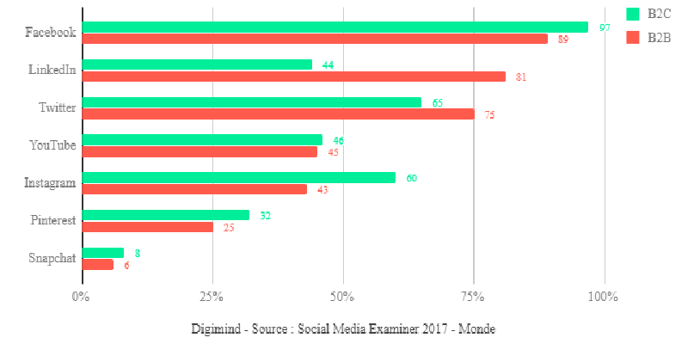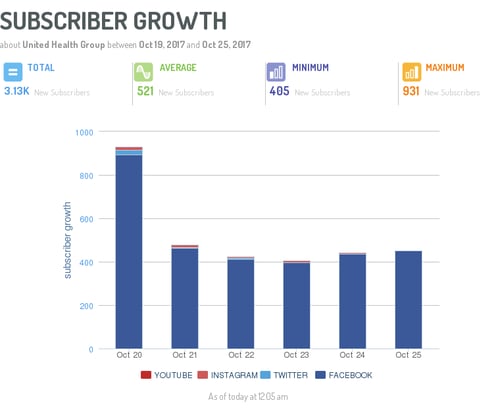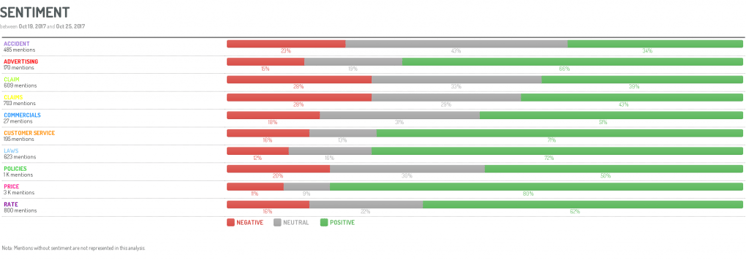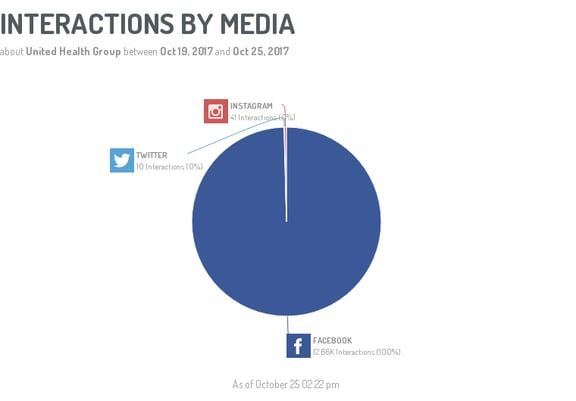5 Objectives to Integrate Into Your Social Media Marketing Strategy
Choosing Objectives for Social Media Strategy.
With the rise of the digital age, brands are becoming more acutely aware of the value of investing in social media strategies. Social media networks are no longer an isolated marketing channel solely dedicated to communication and promotional efforts. Social media has provided measurable results with strategies such as lead generation and social selling, in addition to useful points of contact between brands and consumers.
In 2017, a massive number of marketers used social media as their primary channel for B2B or B2C communications. According to Social Media Examiner, 97% of marketers used Facebook for B2C and 81% used LinkedIn for B2B.
 The percentage of marketers using various social platforms for B2C and B2B, via Social Media Examiner 2017.
The percentage of marketers using various social platforms for B2C and B2B, via Social Media Examiner 2017.By collecting data from social media conversations and applying them to consumer profiling efforts, brands can better understand consumers, create more highly targeted campaigns, and improve efficiency with informed decision-making processes. A crucial part of this process is social listening, a practice that allows brands to monitor and analyze conversations about them on social media. This can be a complex task, so to better understand it, check out our comprehensive guide and tools about social listening.
Social media intelligence enables brands to:
- Heighten brand awareness
- Increase social community size
- Accurately target audiences
- Strengthen engagement strategies for increased brand loyalty
- Increase customer satisfaction and positive brand perception
- Convert social followers into qualified leads and new business
Below are 5 key objectives any brand should integrate into their social media strategies.
1. Develop Brand Awareness
Creating brand awareness shortens the sales process, increases market share, and positions a brand as a leader in its sector. It’s necessary to perform an internal audit to evaluate brand positioning strategies and to understand the impact of marketing actions on brand image.
Brand differentiation can develop from a number of actions such as the creation of original content, personalized promotions aimed at the target audience, prospect profiling, product development based on social insights, and communication strategies adapted for socio-demographics of interest.
Here are some KPIs to help track and report on the success of this objective:
- Mentions: the number of times the brand comes up in social media conversation and the number of times these conversations are shared.
- Impressions: the number of potential views that a message has.
- Reach: the number of people who have received viewed a publication.
- Social Sessions: the number of site visits, blog post views, etc.
- Share of Voice: volume of mentions received by a brand versus volume of mentions received by all relevant competing brands.
 A graphic representing the number of brand mentions over time, via Digimind Social.
A graphic representing the number of brand mentions over time, via Digimind Social.
2. Increase Size of Social Communities and Accurately Target Audiences
The relevant KPIs here are:
- Community Performance: the number of fans, followers, or subscribers broken down by social media channel.
- Community Progression: the follower growth rate by social media channel.
- Share of Community Voices: number of followers compared to those of competitors.
- Share of Voice by Channel: the community size of each social media platform as a percentage of the total number of social followers across all platforms.
- Social Visits: visitors coming to social media accounts coming from the brand’s website or blog.
 The growth of subscribers over time by social media platform, via Digimind Social.
The growth of subscribers over time by social media platform, via Digimind Social.
3. Strengthen Engagement Strategies to Increase Customer Loyalty
The primary objective here is to create a long-lasting relationship between the target audience and the brand. It’s necessary to engage with social media followers who have a certain level of credibility or influence among the target audience.
For example, if your target audience is football fans, an NFL player would have social influence among this demographic. The influencer doesn’t necessarily need to be massively influential on a global level - sometimes a smaller, very active community is more effective than a larger, more passive community. Effective social media strategies should integrate influencers with a committed following and brand ambassadors with high levels of engagement.
The KPIs for this objective are:
- Interaction Performance: the number of interactions (likes, retweets, shares, etc.) and number of comments.
- Evolution of the Interactions: the growth rate of interactions.
- Publication Performance: the number of messages generating an amount of interaction greater than a predefined threshold.
- Influencer Population: the number of influencers and brand ambassadors as a percentage of the community size.
 A breakdown of sentiment associated with key industry terms, via Digimind Social.
A breakdown of sentiment associated with key industry terms, via Digimind Social.4. Monitor Customer Feedback
In order to improve customer experience, it's necessary to capture consumer opinions regarding relevant products and measure consumer satisfaction and evolution over time.
The following KPIs should be measured for this objective:
- Brand Perception: the sentiment associated with the brand and its products, especially in comparison to competitors.
- Evolution of Perception: the percentage of positive versus negative sentiment over time.
- Reputation Score: the sentiments associated with the brand weighted against the community size of each review.
- Response Performance: the response rate to social media interactions.
- Resolution Performance: the number of customer tickets resolved over a given time period.
 Share of social interactions by social platform, via Digimind Social.
Share of social interactions by social platform, via Digimind Social.
5. Convert Social Followers into Qualified Leads and New Business
Towards the end of marketing campaigns, brand content should have generated social media followers and interactions with prospective customers. The associated KPIs here are:
- Number of Leads from Social Media: the share of marketing leads originating from social media which are turned into qualified commercial leads and integrated into the CRM platform.
- Lead Growth from Social Media: the growth rate of conversions from social leads to sales leads.
All of these objectives must be regularly reported for initial analyses, which will then be complemented with predictive and corrective analysis.
How Insurance Brands Develop Social Selling Strategies
